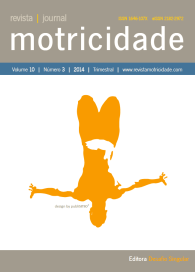Alignment static and dynamic rearfoot does not differentiate subjects with and without patellofemoral pain syndrome
DOI:
https://doi.org/10.6063/motricidade.2743Abstract
Among the various factors involved in the etiology of femoropatelar pain syndrome (FPPS) are the changes in hindfoot alignment. This study aimed to compare the static and dynamic alignment of the rearfoot in subjects with and without FPPS. Participants were 51 female subjects, 23 with a clinical diagnosis of FPPS (FPPSG) and 28 clinically healthy (CG). It was evaluated the static angles of the rearfoot in accordance to the protocol for Postural Assessment Software (SAPO), and dynamic with the Ariel Performance Analysis System (APAS). It was computed independent t-test and ANOVA 2-ways (p≤ 0.05). No differences were observed (p= 0.08) for the rearfoot angle between between static (FPPSG = 7.91°±4.45°; CG = 5.92°±3.69°) and dynamic (FPPSG = 9.57°±3.66°; CG= 9.19°±3.08°) groups. There were also no differences between groups (p= 0.22) comparing the variation between static and dynamic situations (CG= 3.27°±4.59°; FPPSG = 1.65°±4.84°). Subjects with PFPS have no changes in the static and dynamic postural alignment of the rearfoot relative to subjects without this condition.Downloads
Published
Issue
Section
License
The authors of submitted manuscripts must transfer the full copyright to Journal Motricidade / Desafio Singular Editions. Granting copyright permission allows the publication and dissemination of the article in printed or electronic formats and copyrights start at the moment the manuscript is accepted for publication. It also allows Journal Motricidade to use and commercialize the article in terms of licensing, lending or selling its content to indexation/abstracts databases and other entities.
According to the terms of the Creative Commons licence, authors may reproduce a reasonable number of copies for personal or professional purpose but without any economic gains. SHERPA/RoMEO allows authors to post a final digital copy (post-printing version) of the article in their websites or on their institutions' scientific repository.


